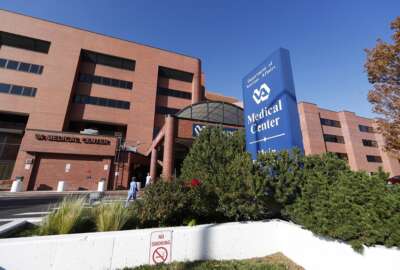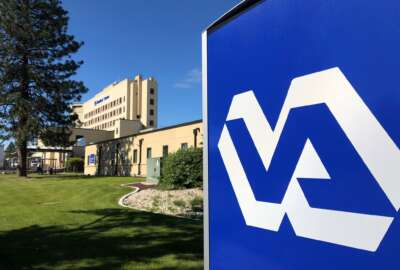VA and the Pentagon look to take advantage of a new spinal procedure for those injured in the line of duty
A new contract awarded to Discseel® Technologies by the Veterans Affairs Department, tasks the company with training physicians to perform a new, non-surgical ...
A new contract awarded to Discseel® Technologies by the Veterans Affairs Department, tasks the company with training physicians to perform a new, non-surgical spine procedure – to all Department of Defense and V.A. hospitals in the United States and overseas. For more on what is called the Discseel procedure, Federal Drive with Tom Temin Executive Producer spoke to its creator, Dr. Kevin Pauza, who is also Chief Medical Adviser and Director of Discseel® Technologies.
Interview Transcript:
Dr. Kevin Pauza Even more recently, we’ve been learning that the veterans across America have this crisis with opioid addiction, and it’s directly tied into the suicide rate. And that was disconcerting to me. And then I recognize that these veterans, and it’s not just veterans, but across the United States are often addicted to opioids, no fault of their own, but they were prescribed them after having spine surgeries. And the failure rate for spine surgery is relatively high. And that causes people to then be on opioids because there’s very few ways to manage. So anyway, that was the problem. I recognized that there was a problem, and my focus early on at the University of Pennsylvania was treating failed spine surgery. So that’s all I saw were people who had failed prior surgeries. And then I recognized that the whole paradigm was wrong, that the majority of surgeries were unnecessary. And there was this industry of medical fusion fueling it. And so many of the spine surgeons knew that we needed changes, but many of them didn’t welcome my changes because I recognized no, instead of, you know, putting bolts and hardware and rods and screws into spines, it would be better to just allow the disks to regrow. And so, you know, for decades, I’ve been working on a way to cause the disc to grow. And the answer was, was almost too simple. Veterans, especially have a very high incidence of chronic low back pain or neck pain, very high incidence. And it’s probably a lot to do with what they do, what they’ve done.
Eric White All right. So the main question, I guess is how does the Discseel procedure work.
Dr. Kevin Pauza With this treatment? What we simply do is we recognize that the discs are usually the cause of low back pain. The discs are the cushions in our back. If it’s torn, that’ll cause it to bulge or herniate or degenerate. That’s the terms they used. But that’s the problem. It’s a torn disc. All disc problems, all disc pathology is directly caused by torn discs, no exceptions. And so we needed a way to heal the discs. And so a way that just made sense was the same way our body heals our skin. So when we take a knife to our skin and its cut, it heals. It heals because our body sends something called fiber into the cut and that heals the cut. And so anyway, having said that, there is an FDA approved drug called Fibrin. Fibrin is what causes everyone’s injuries to heal, skin to heal, or if we injure our spleen, we put Fibrin on the spleen, and it causes the spleen to heal. And even years ago, when they did facial reconstruction, they used sutures. And now we can use fiber and we put it on the face and we don’t need sutures. That’s all the procedure is. The procedure is called the Discseel® procedure. And even though it does seal the disks, to me, the more important part is that the Discseel® procedure causes the growth of new disc tissue. There’s many spine industry people that are, you know, constantly attacking this. But, you know, there’s luckily, though, there’s hope because there’s some very fine spine surgeons who recognize the need for the Discseel® procedure. And so, you know, one of those was the VA in Department Defense.
Eric White Yeah. I wanted to jump in here and find out how did they come to learn about this procedure or did you go to them or did they come to you? Just give me a backdrop on what went down there.
Dr. Kevin Pauza Yeah. Basically, I don’t know how the relationship started with the VA and Department of Defense, except for the fact that I know that I’ve treated many veterans and they’ve been paying out of pocket for the procedure over the years. And somehow the veterans that must have reached out to congressmen or people in the VA or Department of Defense to say, hey, you know, you guys need to know about this because you’re telling my friends to have fusions. And so anyway, it’s that grassroots campaign that started from veterans who I do not know that brought this into the VA and Department of Defense attention. And they reached out to us asking if it was something that we could scale and make available to them. And so I was very, you know, focused on my practice, but I felt there was a much bigger need. And if this could be made available to, you know, who I thought deserved it more than anybody else, that would be the VA and Department of Defense. Then I would, you know, put everything aside and focus on the VA and Department of Defense. And so yes, they signed an agreement that allows me to train all of the physicians and nursing staff. In addition, it pays for the procedure in full for any veteran or active or non-active member of Department of Defense.
Eric White Had to let you know that you were definitely on to something, despite all the pushback you got from the spinal surgery industry that let you know that, oh, well, if these folks are into it and then I got to be on to something. Right.
Dr. Kevin Pauza It was a really good feeling. And it actually turned, it changed my mind about the VA and Department of Defense because it caused me to recognize that they truly do want something that’s better than is being offered out there because they’re actually ahead of the game when it comes to this. Because only now other insurance companies are approaching me. But the VA and Department of Defense took the lead, if you will, and recognized the technology and recognize the data. Reviews are even long before it was made public to anybody out there. So that really caused me to, you know, to respect whatever’s happening in the VA and Department of Defense at a high level, more so than most people give it credit in my experience.
Eric White Then let’s not lose focus of who this actually helps, which is the patients themselves. What have what do you hear from them? Are they you know, I imagine they’re not virtually pain free just because spines are so finicky. But, you know, are they saying that it’s a lot better than the alternative?
Dr. Kevin Pauza Well, that’s a good question. So it’s among one of the largest spine, the studies that’s been done with a registry. So in other words, I so I thought, okay, let me teach other doctors. So I taught a small group of doctors and yes, they could duplicate the results. And then I said, well, let’s see what the results are. And so, yeah, the patients are happy. And so we’ve been following over 700 patients. We’re now at over five years, but we’ve had no adverse events, no complications. There’s no spine surgeon in the United States who can make that equal statement. And the data was all collected independently because this was so, so important and it would be looked at with scrutiny, I felt as a deserve to be. I had the data collected by the actual registry that’s endorsed by the surgeons because I thought they’d be my strongest critics. So it’s a registry that’s supported, endorsed by the American Academy of Orthopedic Surgery that collects all my data, not me. I’m blinded to my data. I couldn’t even access it. But anyway, they looked at everything considered important to a patient. That means that even depression, mental health, disability, function, pain. They looked at eight things and demonstrated what we call statistically significant improvement in everything they looked at one year. And then I thought, well, after one year it’s going to fall off as everything else does. But at two years, the outcomes were even better than one year, and at three years they were better than two years. And that’s probably reflective of the Fibrin’s ability to heal the disc over time. And that’s the opposite of what surgery does, because we know that over time, surgery because it does something unnatural to the spine, worsens the adjacent segments, just the nature of surgery, they can’t help it. It just does that. And this does the opposite and even have a fair amount of patients come in proactively. A lot of them are pro athletes and others who recognize, you know, the value of being proactive and they have their spines treated with the procedure. And I treat several royal families overseas and one of them had me treat all the members proactively because they were plagued with spine pain and spine surgery over the decades prior. And for all those that I treated, none of them have needed spine surgery, you know, after following them for over seven years. So it’s a whole different paradigm. You know, the Discseel® procedure is focused on quickly identifying the tears, and we do that at the same time. So the patients come in, they don’t get put to sleep, but the twilight sedation. It’s called conscious sedation. And then we perform the procedure. That’s where we easily, we direct very small needles into the bottom discs, identify the tears, and then we immediately seal all those tears with Fibrin. And then the patient’s go to recovery. And that takes less than an hour to do, and then in recovery for 30 minutes and then the patients go home and then I want them to start exercise the following day.
Copyright © 2024 Federal News Network. All rights reserved. This website is not intended for users located within the European Economic Area.
Eric White is news anchor and Federal Drive producer at Federal News Network.
Follow @FEDERALNEWSCAST
Related Stories






